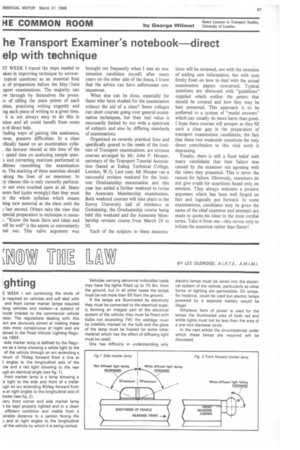ghting
Page 69

If you've noticed an error in this article please click here to report it so we can fix it.
S WEEK I am continuing the study of Cs required on vehicles and will deal with and front corner marker lamps required long vehicles and trailers—a subject of icular interest to the commercial vehicle rator. The regulations dealing with this ect are obviously aimed at making these cies more conspicuous at night and are Cained in the Road Vehicle Lighting Reguins 1964.
side marker lamp is defined by the Reguins as a lamp showing a white light to the of the vehicle through an arc extending a imum of 70deg forward from a line at t angles to the longitudinal axis of the cle and a red light showing to the rear ugh an identical angle (see fig. 1).
front marker lamp is a lamp showing a ce light to the side and front of a trailer ugh an arc extending 90deg forward from e at right angles to the longitudinal axis of trailer (see fig. 2).
very front corner and side marker lamp I be kept properly lighted and in a clean efficient condition and visible from a onable distance to a person facing the 3 and at right angles to the longitudinal of the vehicle by which it is being carried.
Vehicles carrying abnormal indivisible loads may have the lights fitted up to 7ft 6in. from the ground, but in all other cases the lamps must be not more than 5ft from the ground.
If the lamps are illuminated by electricity they must be connected to the electrical supply forming an integral part of the electrical system of the vehicle; they must be fitted with bulbs not exceeding 7W; the wattage must be indelibly marked on the bulb and the glass of the lamp must be frosted or some other material which has the effect of diffusing light must be used).
One has difficulty in understanding why electric lamps must be wired into the electrical system of the vehicie, particularly as other forms of lighting are permissible. Oil lamps, for instance, could be used but electric lamps powered by a separate battery would be illegal.
Whatever form of power is used for the lamps the illuminated area of both red and white lights must not be less than the area of a one inch diameter circle.
In the next article the circumstances under which these lamps are required will be discussed.
























































































































